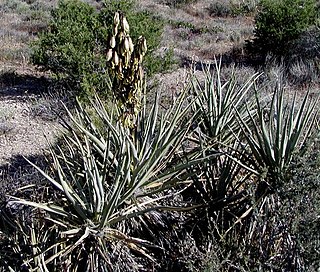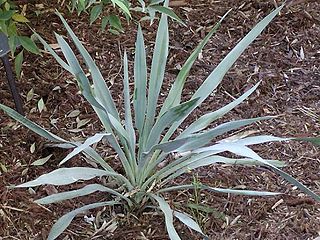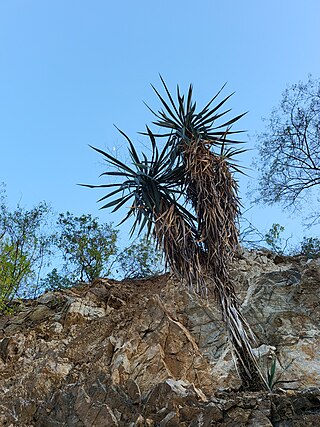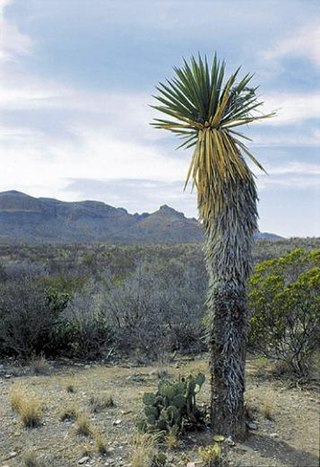
Yucca baccata is a common species of yucca native to the deserts of the southwestern United States and northwestern Mexico, from southeastern California north to Utah, east to western Texas and south to Sonora and Chihuahua. It is also reported in the wild in Colombia.

Yucca pallida, sometimes called pale yucca, is a species of yucca native to Northern Mexico and parts of the blackland prairies of northern and central Texas, and notable for its light-colored leaves that range from a pale blue-gray to sage-green in color.

Yucca elata is a perennial plant, with common names that include soaptree, soaptree yucca, soapweed, and palmella. It is native to southwestern North America, in the Sonoran Desert and Chihuahuan Desert in the United States, southern Nevada, southwestern Utah, and northern Mexico. Yucca elata is widely distributed, although its population appears to be decreasing.

Yucca filamentosa, Adam's needle and thread, is a species of flowering plant in the family Asparagaceae native to the southeastern United States. Growing to 3 metres tall, it is an evergreen shrub valued in horticulture.

Hesperoyucca is a small genus of two recognized species of flowering plants closely related to, and recently split from, Yucca, which is in the century plant subfamily within the asparagus family.

Yucca × schottii is a plant species in the genus Yucca, native to southern Arizona, southwestern New Mexico, and the northern parts of Sonora and Chihuahua. The common names are Schott's yucca, hoary yucca, and mountain yucca. The "×" in the name indicates that this is a nothospecies, regarded as being a natural hybrid between two other species. In this case, Yucca × schottii is believed to have originated as a hybrid between Y. baccata and Y. madrensis. Yucca × schottii is firmly established and does reproduce freely in the wild.
Tegeticula intermedia is a moth of the family Prodoxidae. Along with other moth species, it is commonly known as a yucca moth. T. intermedia lives in North America, particularly the United States. The moth resides in the southwest, the Great Plains, the Southeast, and mid-Atlantic. It also has been found much farther north in regions of Canada like Ontario and Alberta. There are also notable populations present in New Mexico. Their habitats are diverse and vary in terms of climate, landscape, and other factors. The moth lives in sand dunes, forests, glades, grassland, desert, and forests from the East Coast to the Southwest. Yucca moths have developed a strong mutualism with the yucca plant, such that both depend on each other for survival. The yucca moths and yucca plants have coevolved over millions of years. However, Tegeticula intermedia differs from most yucca moths in that it exhibits cheating behavior by laying eggs without pollinating the yucca plant.

Yucca flaccida, commonly called Adam's needle or weak-leaf yucca, is a species of flowering plant in the asparagus family (Asparagaceae). It is native to south-central and southeastern North America, from the lower Great Plains eastward to the Atlantic seaboard in Virginia, south through Florida and the Gulf states. Its natural habitat is in sandy open woodlands and fields. It is not considered to be threatened by the IUCN.

Yucca declinata is a species of the genus Yucca, family Asparagaceae. It is known only from the vicinity of Bacanora, in the Mexican state of Sonora. Botanist Howard Scott Gentry first collected the species and mentioned it in print, noting the differences between this population and the closely related species Y. grandiflora H. S. Gentry and Y. arizonica McKelvey. He did not, however, describe it as a new species. Later examination of his descriptions and his material led to the recognition of this as a new species.

Yucca arkansana, the Arkansas yucca, is a plant in the family Asparagaceae, native to Texas, Oklahoma, Arkansas, Missouri and Kansas. It generally grows in gravelly, sunlit locations such as rocky outcrops, prairies, etc. It is not considered to be threatened.

Yucca angustissima, the narrowleaf yucca, is a plant in the family Agavaceae, known as the "narrow-leaved yucca." It is native to Arizona, New Mexico, Colorado and Utah, but grown elsewhere as an ornamental.

Yucca capensisL.W.Lenz is a plant in the family Asparagaceae. It is endemic to a small region of the Mexican state of Baja California Sur It is considered to be an endangered species by the IUCN due to its small range and threats of habitat destruction. The epithet refers to the type locale is near Cabo San Lucas in the southernmost part of the peninsula. Its common name is the Cape Region yucca.

Yucca baileyi is a plant in the family Agavaceae. It is native to Utah, Arizona, New Mexico and Colorado but has been cultivated elsewhere. Much of its native range is within the boundaries of the Navajo (Diné) Reservation, hence the common name "Navajo yucca." The Navajo people make extensive use of yucca fibers to make a wide assortment of useful and ceremonial items. They also use the roots as soap. It is not considered to be threatened, as it has a large range and an overall stable population.

Yucca carnerosana, commonly known as the giant Spanish dagger, is a species of North American plant in the asparagus family that grows in arid and desert climate areas. In the United States, it is confined to only a few counties in western Texas, where endemic populations are found in rocky outcrops. The species is, however, widely distributed in northern Mexico. It has a wide range and is abundant, and although it has local threats, its population appears to be stable overall.

Yucca constricta known by the common name "Buckley's yucca," is a plant in the family Asparagaceae. It is found in rocky limestone hills of central and eastern Texas, and also in Coahuila, Mexico.

Yucca campestris, the plains yucca, is a species in the family Asparagaceae, endemic to the "panhandle" region of northwestern Texas. It is considered to be endangered, mainly due to habitat loss.

Yucca treculianaCarrière is a species of flowering plant in the family Asparagaceae, native to Texas, New Mexico and Coahuila. Common names include Spanish dagger, Spanish bayonet and Don Quixote's lance.

Yucca utahensis is a species in the family Asparagaceae, native to Utah, Nevada and Arizona. McKelvey

Hesperoyucca peninsularis, the peninsular candle or lechuguilla, is a plant species endemic to the Baja California peninsula. It is a perennial forming a rosette. It is semelparous.
Susan Adams Delano McKelvey (1883–1964) was an American botanist and writer, noted for her work at the Arnold Arboretum. The standard author abbreviation McKelvey is used to indicate this person as the author when citing a botanical name.




















